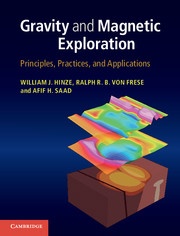Book contents
- Frontmatter
- Dedication
- Contents
- Preface
- Acknowledgements
- 1 Introduction
- Part I Gravity exploration
- 2 The gravity method
- 3 Gravity potential theory
- 4 Density of Earth materials
- 5 Gravity data acquisition
- 6 Gravity data processing
- 7 Gravity anomaly interpretation
- Part II Magnetic exploration
- Part III Applications
- Appendix A Data systems processing
- References
- Index
6 - Gravity data processing
from Part I - Gravity exploration
Published online by Cambridge University Press: 05 May 2013
- Frontmatter
- Dedication
- Contents
- Preface
- Acknowledgements
- 1 Introduction
- Part I Gravity exploration
- 2 The gravity method
- 3 Gravity potential theory
- 4 Density of Earth materials
- 5 Gravity data acquisition
- 6 Gravity data processing
- 7 Gravity anomaly interpretation
- Part II Magnetic exploration
- Part III Applications
- Appendix A Data systems processing
- References
- Index
Summary
Overview
Gravity observations include the combined effects of instrumental, surface, terrain, and planetary sources in addition to the subsurface mass variations that are the objective of an exploration gravity survey. To isolate the effects of subsurface sources, extraneous effects which include both temporal and spatial variations are removed from the data using theoretical considerations, geological information, and empirical observations. Some are considered universally, but others only in specific geological, surface, and observational conditions. There is an increasing need to eliminate a broader range of extraneous effects more precisely as the objectives of gravity surveying require higher precision and accuracy and are focused on both long- and short-wavelength anomalies. Unwanted effects are removed by calculating the gravity anomaly, which is the arithmetic difference between the observed vertical acceleration of gravity and the predicted or theoretical acceleration at the observation site. Theoretical gravity is based on a conceptual model of the sources of gravity variations. This model varies depending on the intended use of the gravity anomaly and the conditions of the survey.
Three classes of anomalies are recognized. The primary class, planetary anomalies, incorporates only analytically determined planetary considerations in the theoretical model, e.g. the Bouguer gravity anomaly. A second type, geological anomalies, applies additional effects from known or postulated subsurface geological conditions in the model, e.g. the isostatic residual gravity anomaly. The third type, filtered anomalies, is calculated by removal of arbitrary gravity effects caused by unknown sources, empirically or analytically determined by filtering that enhances particular attributes of the spatial pattern of the anomalies, e.g. wavelength-filtered gravity anomalies. The latter type seeks to isolate or enhance those of interest at the expense of other anomalies.
Information
- Type
- Chapter
- Information
- Gravity and Magnetic ExplorationPrinciples, Practices, and Applications, pp. 122 - 174Publisher: Cambridge University PressPrint publication year: 2013
Accessibility standard: Unknown
Why this information is here
This section outlines the accessibility features of this content - including support for screen readers, full keyboard navigation and high-contrast display options. This may not be relevant for you.Accessibility Information
- 1
- Cited by
